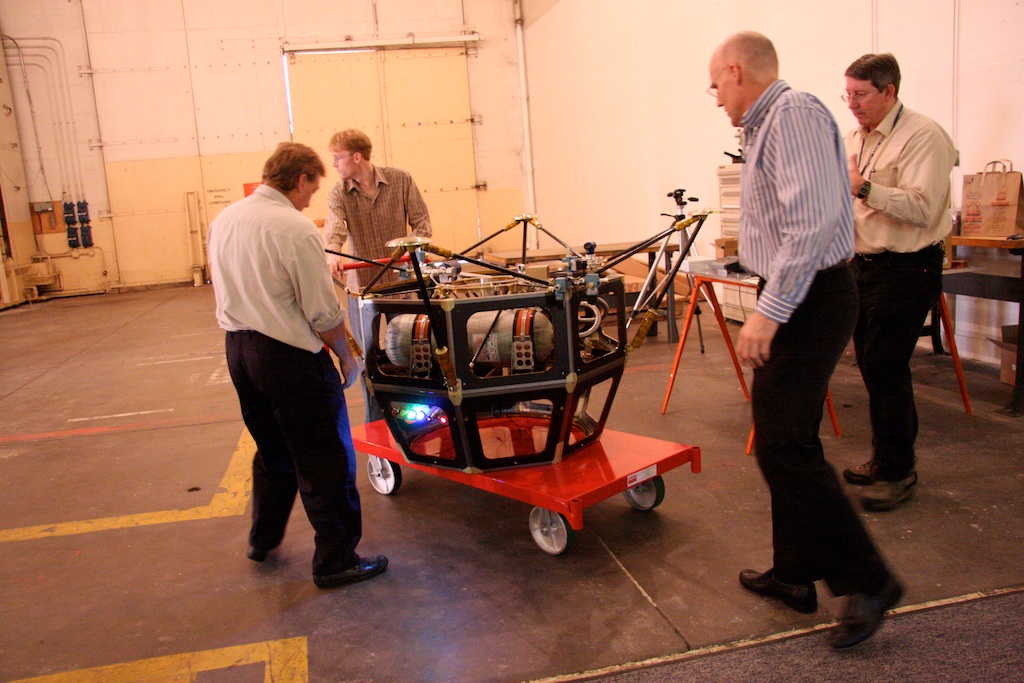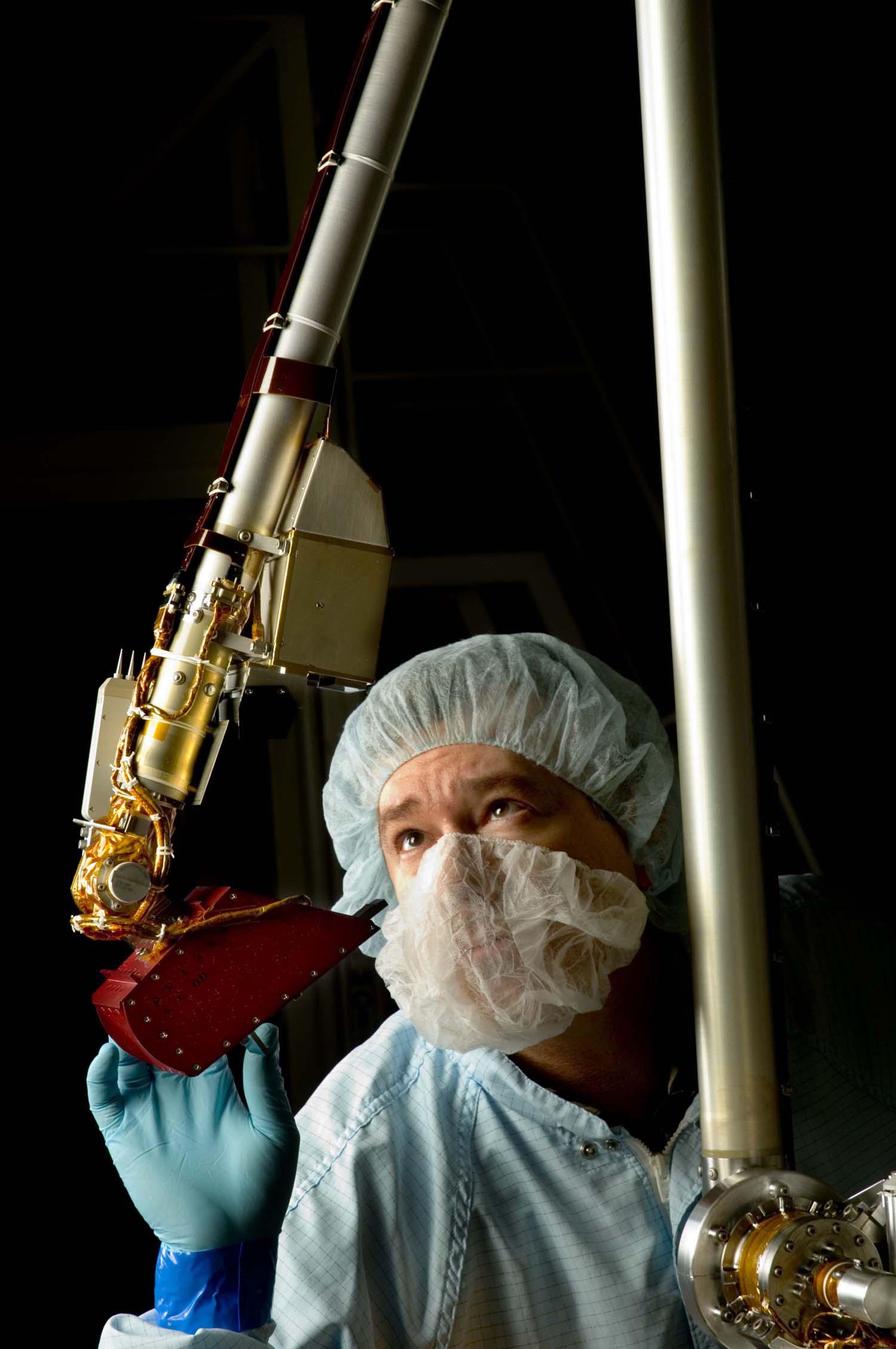
By Matthew Kohut
Suppose you had to design a door within a lunar lander module that would shield the crew habitat from solar activity during a moon mission. Assuming this isn’t already your day job at NASA, how would you begin to devise a solution?
That’s the question that two dozen participants wrestled with over a three-day period at Ames Research Center last fall. Their brainstorms, deliberations, drawings, and prototypes were the central group activity of Innovative Design Engineering Applications (IDEAS), a new course offered by the Academy of Program/Project and Engineering Leadership that focuses specifically on the challenge of design. IDEAS introduces a variety of tools that engineers can use to help conceive, develop, and test new design concepts. The emphasis on variety is deliberate because there is no single approach that works well in all contexts. “The design practice of systems engineering is more of an art learned through experience,” said course instructor John Sturrock.

Teams brainstorm, sketch, and build possible solutions for projects during the IDEAS course.
Photo courtesy John Sturrock
Day One: Divergent Tools
“Is brainstorming a soft or hard tool?” John Sturrock asked the class.
“Soft.”
“How about Design for Six Sigma?”
“Hard.”
Sturrock hadn’t defined “soft” or “hard.” Participants shared common assumptions about what these metaphors meant. This wasn’t terribly surprising since all were NASA engineers working in very similar organizational settings, but those same words could have different meanings to people in different contexts. His point: an over-reliance on verbal communication in the design process can introduce ambiguities or misunderstandings.
The class also examined visual thinking, which highlighted the importance of drawings and sketches. It explored kinesthetic learning through a case study focusing on the design of the astronaut seat for the Orion vehicle. The case recounts the experience of the lead designer of the seat, who was having trouble arriving at a design solution through the use of software-based visual tools such as Pro-Designer and AutoCAD. By building a prototype seat in his garage, he was able to touch and feel how the controls and handling worked, leading to new breakthroughs.
Day one emphasized divergent tools, which are a means of gathering a wide range of ideas. Brainstorming is a divergent tool. Selecting team members with diverse backgrounds who haven’t worked together is another one. Divergent tools offer the promise of enhancing creativity but no guarantees. “Design is an unstable activity,” said Sturrock. “Not only do we not know where we’re going, but we change our destination as we go.”
“Much time was spent on exercises meant to demonstrate that we never get a ‘full picture’ of possibilities and we are inherently biased in our focus of attention,” said Silvano Colombano, a computer scientist in the Intelligent Systems Division at Ames. “A wider, more unbiased coverage of problems and solutions comes at a cost. The real difficulties in innovative design are the cost–benefit analysis associated with eliminating biases, and how to organize groups of people so that the best possible solutions can be obtained by their combined brain power.”
Participants broke into small groups and began brainstorming designs for their lunar habitats, generating as many ideas as possible. Sturrock encouraged the groups to follow the practice of design firm IDEO and refrain from judgments or criticisms during these initial sessions: the goal was mass creativity. Water was a key design element because of its ability to act as a radiation shield. How about a revolving door with one side filled with water? A flexible water curtain? A water-filled sleeping bag for each crewmember? There would be time to sort, rank, and criticize the next day.
Day Two: Convergent Tools
The hard tools of design come into play at the point where creativity meets engineering rigor. Quality Functional Deployment (QFD) sets customer requirements alongside business processes to determine strong and weak correlations. The Pugh matrix (also known as a criteria-based matrix) offers a simple means of scoring and ranking concepts against requirements. Design for X (DFX) looks at design in terms of a certain functional aspect, such as “design for maintenance and serviceability,” “design for reliability,” or “design for manufacturing and assembly.” These kinds of tools enable designers to converge on ideas that are worthy of further time and energy.
“Tools like the Pugh decision matrix, brainstorming, and innovation have their application to my everyday job. Many of the design decisions that get made are done so for specific reasons and require data to back them up,” said Joe Matus, a systems engineer from Marshall Space Flight Center. “When designing a one-of-a-kind vehicle or experiment, or a limited quantity launch vehicle with critical performance parameters, it is important to weigh the myriad solutions that are available and to choose the one that makes the most sense in the overall scheme of things. Once a forward path is chosen, it can be quite costly to decide later that it is not the correct one.”
Participants then used the convergent tools to score and rank their lunar habitat designs from the first day. The water sleeping bag would never pass muster with the crew. A revolving door or some sort of ball valve might work. The good designs would make it to day three.
Day Three: TRIZ, Open Innovation, and Final Projects
Participants spent the first part of day three discussing some other valuable techniques for spurring and guiding innovation. One is the Theory of Inventing Problem Solving. While working as a patent examiner in the Soviet Union in the mid-1940s, Genrich Altshuller, a Soviet engineer, developed a rigorous taxonomy of inventions, focusing on how patent applicants solved problems. He found that there were forty inventive principles that were used time and again, regardless of the industry or technical discipline, to solve common technical contradictions. This led him to the Theory of Inventing Problem Solving, which became known worldwide by its Russian acronym TRIZ.
Another is open innovation, one of the most dynamic developments in the design world over the past decade. The open-source software movement is the leading example, though the practice has spread to countless industries and manifested itself in multiple ways throughout NASA, ranging from the Innovative Partnerships Program to the Centennial Challenge competitions it has sponsored. In the world of design, nobody has a monopoly on the answers. It pays to look everywhere.
The final activity brought the small groups together one last time for a ninety-minute rapid prototyping session. The lunar habitat designs that had been brainstormed on day one and analyzed on day two took shape with Styrofoam, aluminum foil, paper plates, and Scotch tape. Each group made a short presentation to the class, and then participants voted for their favorites. Photos and sketches of the best designs would be shared with the lunar habitat design team at Johnson Space Center.
The IDEAS session at Ames marked the second time the course had been offered at NASA—it had been held earlier in the summer at Kennedy Space Center. It is easy to envision future sessions held specifically for newly formed design teams or new hires at the Agency. The challenge of developing innovative designs will be waiting for them.









